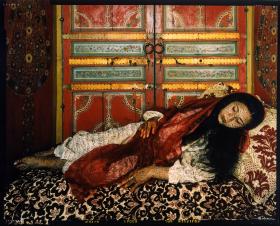
Moroccan born, Lalla Essaydi did not become an artist until relocating from Saudi Arabia to the United States in 1996. She believes her work—autobiographical writings inscribed on women’s bodies and cloth and captured through photography—would not have been possible had she stayed in Morocco and Saudi Arabia. She says, “In a sense I am a Western artist, making art in a style I was unable to use in my home country . . . I want to combine all these elements in order to engage the whole problem of myself as other.”
Essaydi is best known for her photographs of women clothed in expansive swaths of cloth inscribed with volumes of handwritten calligraphic script recounting the artist’s personal experiences. This in itself is a subversive act, since calligraphy is an expressive form traditionally reserved for men in Arabic cultures. Even more, the writing is applied in henna, a dye associated with women’s adornment rather than calligraphy, learning, or meaningful narrative. Even her choice of surfaces on which to write, cloth and skin, challenge convention.
With intense, jewel-like tones and ornate architectural details, Essaydi’s Three Silences series powerfully evokes the Orientalist imagery she seeks to expose. Rather than simply replicating the centuries-old Western tradition of exoticizing the Orient and the female body, the artist inserts her own narrative into the image, thereby inviting viewers to reconsider mythologies of an imaginary notion of the Far East. Silence of Thought #2 captures the subject in private, at rest in the peace of her own feminine space. By incorporating Orientalist and feminist themes, as well as woman’s relationship to spaces, Essaydi speaks to the boundaries of Muslim female identity, while inscribing these spaces with a feminine voice through her text.

